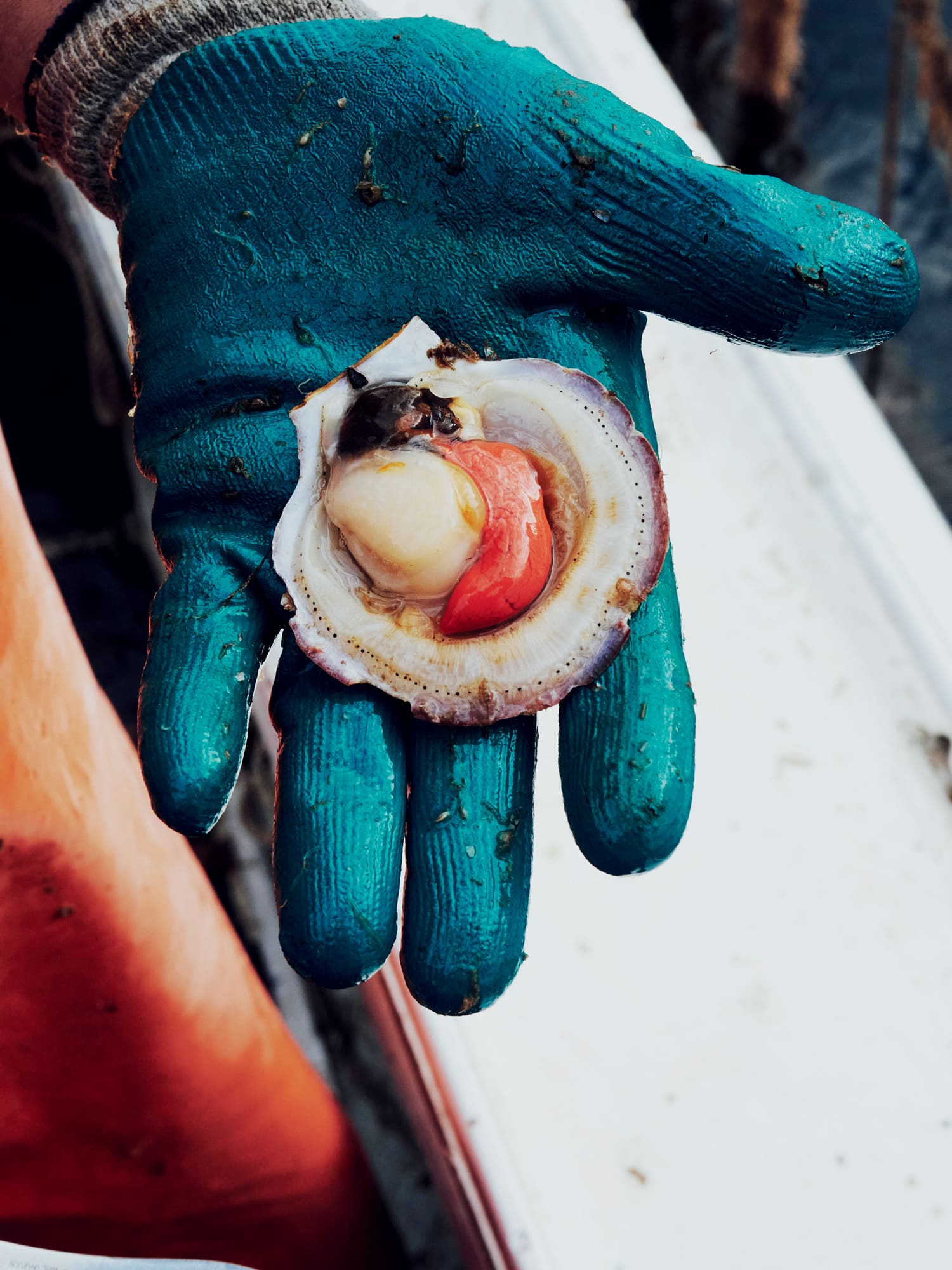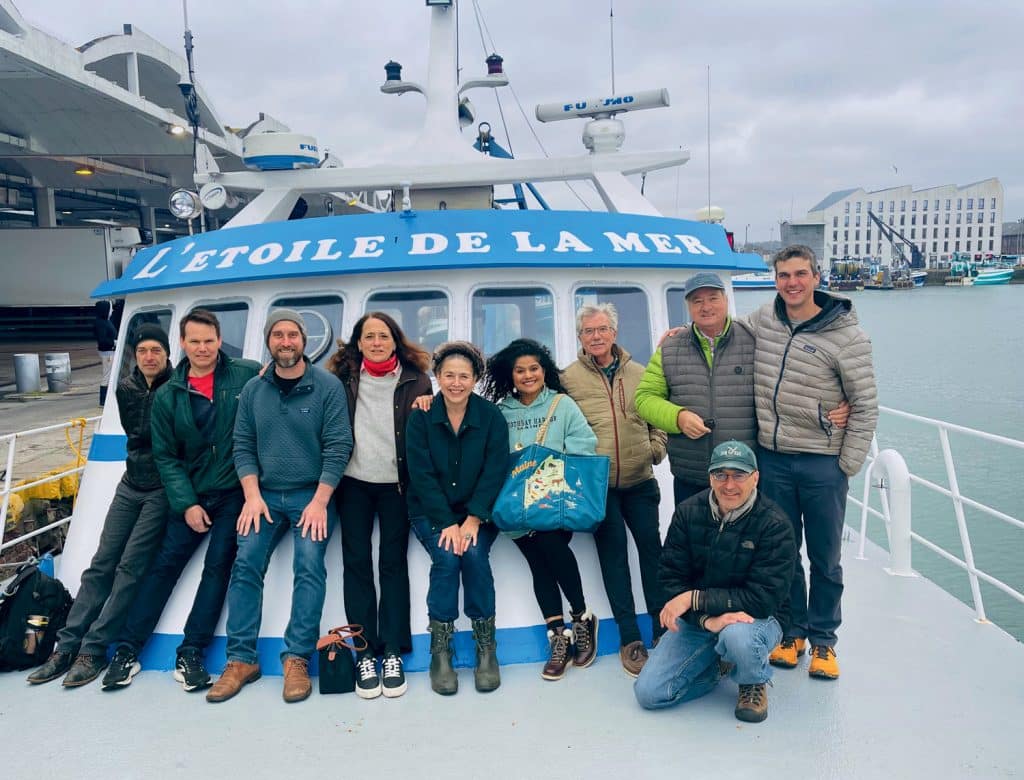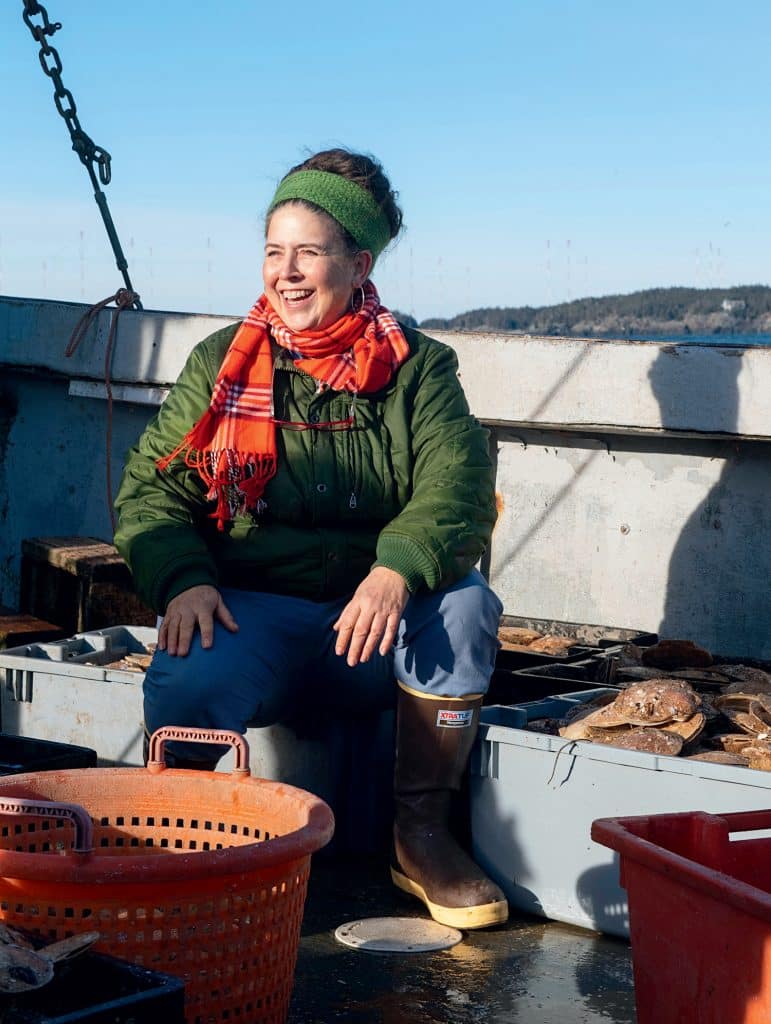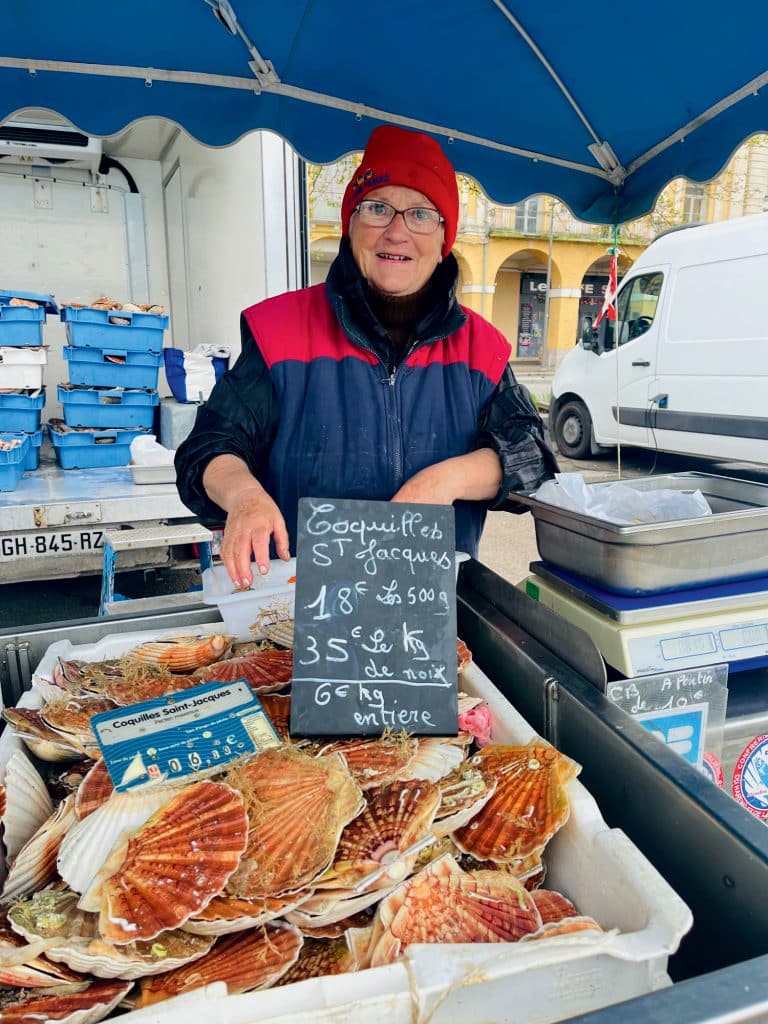The French Connection | Maine’s French-Inspired Scallop Revival
If one day scallops become Maine’s most prized seafood, history may point to a fateful trip to the Old World.

Coffee By Design | Portland, Maine
Photo Credit : Katherine KeenanThe town of Paimpol lies 3,000 miles east of Maine along France’s northern coast, which makes it an unlikely place to glimpse the future of Maine seafood, but one look at the craggy waterfront, stone houses, and fishing boats rocking in the cold Atlantic and we get it. I’m tagging along with a delegation of eight Mainers who would like to make the scallop Maine’s Next Big Thing, so we’ve come to the region that wrote the playbook. The Fête de la Coquille Saint-Jacques, held every April on the Côtes-d’Armor, draws 50,000 scallop lovers for a two-day binge of scallop kebabs, scallop rolls, fried scallops, seared scallops, and yes, scallop beignets. You can tour fishing boats, hosed clean for the occasion, and seize the rare opportunity to buy 10-kilo sacks of live scallops in the shell—a bargain at 35 euros—and cart them off to your vehicle with the help of on-site wheelbarrows.
Leading the love for all things coquille is the Confrérie des Chevaliers de la Coquille Saint-Jacques des Côtes-d’Armor, the Brotherhood of the Knights of the Scallop of the Armor Coast. France has hundreds of confréries devoted to regional specialties. There are Truffle Knights and Strawberry Tart Knights. It’s what you do in retirement instead of joining the Elks Club. The Knights of the Scallop don yellow capes and golden medallions and lead a parade to get the festival rolling. Then they spend the rest of the year promoting scallop amour in France’s restaurants.
Their grandmaster, Alain Dornadic, along with a second member also named Alain, walks us through the festivities, explicating the fine points of scallop cookery. “Never with french fries,” Alain 1 says, pointing to several offenders on the main drag. “Always rice.” He has a pointy white beard and a woolen flat cap and looks every bit the retired French chef he is. He urges us to avoid some common mistakes when cooking scallops, such as shaking the pan, which forces water out of the scallops and prevents a good browning. “Just turn them once very gently with tongs.”
Our group nods politely, but frankly most of this crew graduated from Scallops 101 years ago. We’ve got Sam Hayward, dean of Maine cuisine; Robert Dumas, who leads food innovation efforts for the University of Maine; and certified Master Chef of France Jean-Louis Gerin, who was Dumas’s mentor at the New England Culinary Institute and who has graciously called on his French connections for us. We’ve got Andrew Peters, one of the two people in Maine attempting to farm scallops on a commercial scale instead of fishing them wild; Togue Brawn, a one-woman powerhouse of scallop enthusiasm whose Downeast Dayboat delivers straight from the sea to restaurants and individual customers; and Dana Morse, who has been rolling the Sisyphean rock of Maine scallop culture uphill for most of the 25 years he’s been the aquaculture guy for Maine Sea Grant and the University of Maine Cooperative Extension. We’re here thanks to a grant that Morse scored from the National Oceanic and Atmospheric Administration (NOAA) to facilitate a knowledge transfer between the seafood-crazed regions of Maine and France.

Photo Credit : Cherie Scott

Photo Credit : Nicole Wolf
We pass another group dressed in yellow robes and scallop-shaped medallions, and a chill can be felt in the air. We quickly decamp to the Alains’ favorite portside restaurant—the chef was recently inducted into the confrérie—so they can explain. There has been a schism in the brotherhood. No need to go into the sordid details (at the annual meeting, somebody bought frozen American scallops by mistake), but the upshot is that a faction has broken away to form the Confrérie Coquille Saint-Jacques Pêchée en Côtes-d’Armor, or the Brotherhood of the Scallop That Is Fished in Côtes-d’Armor. They have their own robes and patches and snazzy yellow driving caps with white shells on top. “It’s fine,” Alain 2 says, unconvincingly. “We’re better off without them.”
What matters to me and the rest of our contingent, as we nibble on scallop brochettes served with the bright orange crescent of roe still attached (and just try finding that in the U.S.), is not so much that there are two chapters of Scallop Knights in France (well, three if you count Saint-Méloir-des-Ondes, but of them we will not speak), but that there are any at all. In America, scallops are essentially the chicken nuggets of the sea. Firm, mild, and easy to cook, scallops are popular more for their versatility than their perceived character. But in France, their greatness is a given, even fought over. So why not in Maine? “We need to become the culinary center of scallop culture in the U.S.,” Morse says, blue eyes lit with conviction. “Massachusetts has the quantity, but we have the quality.”
That’s the crux of it. In the U.S., 95 percent of scallops are fished by big boats and vertically integrated corporations based in New Bedford, Massachusetts, the undisputed scallop capital of the universe and the most lucrative fishing port in America. These 100-foot “trip boats” will spend a week or more dredging scallops from Georges Bank, the giant underwater shelf 60 miles off the coast of Cape Cod that is the mother lode of scallop beds, returning to port with tens of thousands of pounds of meat—meat that’s been sitting around. “If it’s coming off a trip boat, it’s potentially sat in a sack for 10 days surrounded by melting ice,” Brawn explains. The meat absorbs water, diluting the flavor and preventing the scallops from developing a nice crust in the sauté pan.
That doesn’t happen in Maine, where the tiny supply of scallops is caught by day boats—smaller vessels, usually lobster boats, that fish closer to shore and return to port that same day. These “dry” scallops never touch water after being harvested and retain their concentrated sea essence. “I don’t want to diss the big boats,” Brawn says. “Trip-boat scallops are perfectly fine. But there is a big difference between a trip-boat scallop and a day-boat scallop, and I want the day-boat fishermen to be getting more money for their product.”
So far that rarely happens. Despite more than a dozen years of spreading the gospel, Brawn has barely managed to expand the pool of Americans willing to pay the premium necessary to make the business sustainable. So what’s different about France?
Well, for one, the scallop. This is most obvious in the shells. While our Atlantic sea scallop, Placopecten magellanicus, has a smooth, brownish-pink shell that is, let’s face it, a little boring, France’s king scallop, Pecten maximus, is stunning, with a deeply fluted orange shell that is the kind of thing Botticelli would paint and Venus would ride around in. Even the French name for Pecten maximus, coquille Saint-Jacques, refers to the sacred nature of the shell, an iconic route marker for the famous pilgrimage to the tomb of Saint James (Saint Jacques in French) at Compostela.
Might French scallops outclass America’s in ways beyond the shell? The thought haunts us, and a reckoning awaits: Brawn has smuggled 20 pounds of her frozen day-boat scallops in her luggage, to be handed out to any open-minded aficionado we meet. For now, however, our goal is simple: Meet the chefs, the fishermen, the scientists—and most important, the beast itself.
* * * * *
How much do you know about scallops? It turns out I knew less than I thought. That nugget of meat you find at the seafood counter, for example? That’s just their swimming muscle.
Yes, scallops swim. Don’t let these bivalves fool you. Unlike oysters, clams, and mussels, scallops are pretty mobile. When disturbed, they clap their shells together and squirt water out their hinge end, clattering along comically like a set of wind-up teeth. (That ability makes them trickier to farm than other shellfish. Peters employs a Japanese technique called “ear hanging” that involves threading a thin line through the edge of each scallop’s shell and attaching them to a central line hanging down in the water, so they can roam around like tethered livestock.)
Scallops have hundreds of tiny sensory tentacles for sampling the water around them and dozens of retractable blue eyes that peer out from the edge of their shell. In the wild, they spend most of their time sitting on the bottom of the sea and filtering water across their gills, straining out the plankton.
That life strategy made them sitting ducks for the New England groundfishing industry in the 20th century, whose nets scooped up most of the scallop supply along with the cod and haddock. Badly overfished, they were on few cooks’ radars by the 1990s, when NOAA began closing the primary New England groundfishing areas. Cod never recovered, but scallops’ fecundity allowed them to bounce back after a few years of protection. By 2004, areas off Cape Cod, such as Georges Bank and Nantucket Shoals, were booming. Landings rose from 10 million pounds to 50 million pounds, and scallops began gracing the tables of America’s finest restaurants. Today, scallops are nearly as valuable to Massachusetts as lobster is to Maine.
And much of that wealth accumulates in the coffers of a handful of players we could call Big Scallop. In most fisheries, fishermen are free to sell their licenses to the highest bidder. This has resulted in massive consolidation, as bigger players snatch up more and more licenses. Intended to introduce efficiencies of scale, which can bring down prices and benefit consumers, it also leads to a world where fishermen are mere employees in a big machine.

Photo Credit : Cherie Scott
But one place has staunchly resisted this trend. “Maine is the last Yankee outpost,” Brawn declares with characteristic high intensity as she pilots our minivan through the rolling fields of Normandy, land of cream and Calvados, en route to a meeting with France’s top scallop scientists. “It’s the last place on the East Coast that still has this arcane style of fisheries management where you can’t sell your license.”
In Maine, you keep your license for as long as you fish, and when you retire, it goes to whoever is next on the list. That, along with a culture that prizes independence, has led to what Brawn calls romantic inefficiency: small boats, high quality, working waterfronts distinguished by character rather than sameness.
Brawn came to love the beauty of that culture growing up in Cape Elizabeth, Maine, the daughter of a part-time lobsterman and fishing guide. (While her given name is Kristin, she goes by her nickname, Togue, which is Mainer for lake trout.) She went away to Duke for college, but soon came back and landed a job tending bar at J’s Oyster, a notorious dive on the Portland waterfront. She learned to deal with people of all kinds, from tourists to disgruntled fishermen, and she became a fixture on the waterfront scene. When the local drunks had reached their limit, she would literally waltz them out the door so they could leave with their dignity intact.
She soon scored a job with Maine’s Department of Marine Resources (DMR), which allowed her to put her marine policy interests into action. “There were two management committees: one for lobster, and one for everything else. I got everything else.” Even with the state job, she kept tending bar at J’s to keep it real. “People would say, ‘She’s got a degree in marine biology,’ and I’d say, ‘No, I don’t study fish. I study fishermen. And they’re much more interesting.’”
Brawn has a penumbra of frizzy hair that seems to move of its own accord, a hearty laugh, and a leap-before-you-look attitude that has mostly served her well, but not always: Our minivan hadn’t even made it out of the airport rental facility before losing a side panel to a corner curb. At DMR, she channeled that energy into reviving Maine’s scallop fishery, which she saw as healthy insurance for an economy that had become dangerously dependent on lobster. She helped to implement a series of three-year closures in Maine state waters, during which certain areas would be left alone to repopulate, following scallops’ natural boom-and-bust life cycle. It was a hard sell to the fishermen. “The way you create long-term gains is by forcing short-term pain,” she says. “I got yelled at a lot. But the more pissed off people get, the calmer I get. J’s was great for that.” The plan worked. Maine now has a thriving inshore scallop fishery.
Yet it has struggled to cash in on that success, because the market is not set up to differentiate. Whether it’s from a Cutler day boat or a New Bedford trip boat, almost every scallop gets sent to Massachusetts to be sold at the daily auction—a situation that makes it difficult for small-boat fishermen to survive. “Injustice really galls me,” Brawn says as we drive. “I was at a meeting in Jonesport, and a fisherman was saying he never knew what he was going to get paid for his scallops. And I had this aha! moment. Like, why is this fisherman, with his 80 pounds of scallops that he harvested three hours ago, having his price set by the offshore fleet? It makes no sense to truck our delicious Maine day-boat scallops out of state to be mixed in with the federal fishery. It’s like pouring a bottle of Dom Pérignon into a vat of Barefoot Bubbly!”
The metaphor is apt. Like wine, scallops from different locations taste different. “When I was at DMR, a woman out of Stonington said to me, ‘You know, a Stonington scallop is the best scallop in the water!’ And I remember thinking she was crazy, there’s no way there’s a difference in flavor, but lo and behold, as I started to get into scallops, I realized she was absolutely right.”
Brawn can tell a Cobscook Bay scallop (“soft, creamy, sweet”) from a Casco Bay (“gamy”), a Vinalhaven (“coppery”), or a Frenchman Bay (“consistently well-rounded”). Gouldsboro Bay, a long, thin, well-enclosed bay with a natural gyre that keeps its larval scallops from mixing with other populations, produces unique scallops with extraordinary depth of flavor.
But who’s going to know? Big Scallop not only controls 95 percent of the resource, it also has an iron grip on the processors, the distributors, and the promo money. And it isn’t about to sing the praises of day-boat scallops, says Brawn. “That would be sort of a tacit admission that their scallops are inferior.”

Photo Credit : Pascal Rossignol/Reuters/Redux
So the goal of Downeast Dayboat is to cut out Big Scallop and go straight to chefs and consumers, labeling each delivery with the provenance of the catch and the name of the boat and the skipper. It adds a new dimension to scallop appreciation that can be delightful. For instance, I now know that I’m partial to the robust scallops that captain Alex Todd pulls out of Casco Bay aboard the F/V Jacob and Joshua.
Brawn has expanded what she calls her “David and Goliath battle” to the federal scallop fishery that begins three nautical miles offshore, where Maine territorial waters end. For many years, this fishing area, known as the Northern Gulf of Maine, was little more than an afterthought for Big Scallop, because it took much longer to bounce back than the banks off Cape Cod. But Brawn knew it would eventually, and that it could be a godsend for Maine’s independent scallop fishermen—if it could be protected. The existing regulations placed no limit on the number of scallops the trip boats could take from it.
At the time, it didn’t really matter, but Brawn foresaw the insanity that would result when the area reopened. “One big boat could go in there and wipe out the whole resource before the small boats had a chance!” For years, she lobbied the management council that sets the regulations to fix the problem. “I just kept going back and saying, ‘We gotta close this loophole! This is insane!’ And nobody would listen to me. They said, ‘We’ll deal with it when we need to.’”
They didn’t. In 2016, the scallop population exploded in the Northern Gulf of Maine, and the big boats found it. Over the next two seasons, they harvested millions of pounds of scallops from the tender region while Brawn and others screamed for new regulations.
But this time, Goliath overplayed his hand. The rapaciousness had been so over the top that the authorities finally changed the rules. Today, the first 800,000 pounds per year from the Northern Gulf of Maine is reserved for day boats, and since the current quota is just north of 420,000 pounds, it’s all going to them.
Brawn’s dream of a day-boat-only fishery is real—if she can get consumers to support it. “Maybe I’m just an idiot,” she says as we wend our way through tiny villages on roads that are a terrible match for her and her minivan. “I’ve been doing this for 13 years, and I’ve still never made a profit. I’d like to think that at some point in the future, people will realize just how special Maine scallops are. I don’t quite get why it hasn’t taken off yet.”
With any luck, the people we are here to meet can help us with that.
* * * * *
We check into a giant seaside Airbnb nestled between two old German gun emplacements, the black North Atlantic crashing against the stony beaches where World War II turned, and hustle to a meeting on the Port-en-Bessin harbor with four men who know as much about scallops as anybody in France. Arnauld Manner, Dominique Lamort, and Eric Foucher are scientists in charge of managing Normandy’s scallop fishery. Dimitri Rogoff is president of the Normandy fishermen’s association. The scientists are rail-thin; the fisherman is Falstaffian. From offices overlooking a medieval harbor where small fishing boats bob behind a stone breakwater, they sketch out a system that is straight out of Maine’s deepest fantasies.
In France, they explain, there are no trip boats. There are no scallops soaking in ice water. There are only small boats and day trips. Everything comes to port live, still in the shell. Everything gets sold for a premium and whisked to market that same day.
How, we ask, is such a thing possible?
“We are a country of gourmets,” Rogoff points out, as if nothing could be more obvious. Nobody would accept anything less.
We all nod knowingly and try to convince them that Maine is, too. The landscapes, the seascapes. Everybody knows a fisherman. Everybody cares.
The Frenchmen look dubious. “Don’t Americans just eat fast food?”
We argue our case, and as we do, the parallels keep growing. Normandy rotates its open areas, just as Maine does. The quotas are very conservative—short-term pain, long-term gain—but here, again, nobody argues.
Yet they also have their own Goliath to deal with. French territorial waters extend 12 nautical miles from shore, but the scallop beds they so carefully manage extend farther than that, and big boats from England fish them hard year-round with full support from the U.K. government. Every few years, another battle in “the Great Scallop War” flares up. The most serious came in 2018, when 40 of the small French boats intercepted the British boats and turned them back. Vessels collided, hardware was thrown, windows broken, outrage registered. “For the Brits, it’s an open bar,” Rogoff complained to the BBC at the time. “They fish when they want, where they want, and as much as they want.”
By the end of our meeting, the two groups are fully bonded in their outrage and passion, and we pop our big question: Will they join us for dinner at our place? And perhaps they can bring some of their own scallops for a little friendly competition?
Game on.
In 1976, the world of fine wine was rocked by a tasting that came to be known as the Judgment of Paris. A band of upstart Napa Valley winemakers brought their best bottles to Paris and had them judged blind against the best of Bordeaux and Burgundy by a panel of top critics, both French and American. At the time, it was widely believed no U.S. wine could ever compete with the French classics, but American bottles carried the day. Although the French protested loudly, the Judgment of Paris marked American vinology’s coming-out party.
Could our Judgment of Normandy do the same for scallops? There’s no way to make it blind, but that just makes it more fun. The Frenchmen arrive with scallops and cider from family orchards. Rogoff dismisses the cider and Calvados we’ve picked up with a wave of his Gallic hand and replaces them with his. We toast friendship, France, Maine, and of course coquilles Saint-Jacques.
Then we get down to business.
Manner reduces the cider until syrupy, then sears his scallops and nestles them into a bed of caramelized apples blanketed with the thick, bubbling syrup. For Team Maine, Dumas sears our day-boat scallops on a griddle and covers them in a sauce made from shallots, mushrooms, butter, Calvados, and crème fraîche. Both American and French scallops also get the crudo treatment, served thin and raw and sprinkled with sea salt that Morse evaporated on his woodstove back home. We fill our plates with the bounty of this bountiful place.
By the time the scallops are gone, the sauce mopped up with baguettes, and the bottles of Calvados are out, Brawn and Rogoff are old drinking buddies, swapping notes on merroir, and this president of Normandy fishermen has convinced us that Maine must stay the path at all costs. (“Togue, you and I defend more than seafood products,” he writes her in a follow-up fan note. “We defend seafarers and the coastline on which we love to live and work.”) The only thing they don’t see eye to eye on, predictably, is who has the better scallop. To a person, the Frenchmen prefer their scallop. To a person, the Mainers like theirs.
But I have no dog in this hunt, so I can tell it straight. There is something sweet and dreamy about the sea, a collective memory of brine and tides we’ve long forgotten, but every now and then something triggers a half memory: a fish on your line, a rock in the breakers, a tidepool of urchins, a salty cottage. To me, scallops have always been the finest emissary of that primordial bouillabaisse. Yet the rich kiss I’d assumed to be the essence of all scallops turns out to be the signature of Placopecten magellanicus, the Atlantic sea scallop. I’ll never take it for granted again. But I will, if need be, throw on a yellow cape in celebration—accented, perhaps, with an orange ascot and a necklace of a few dozen blue beads. And wherever the day-boat scallop needs a champion, I and my brochette will be ready.







